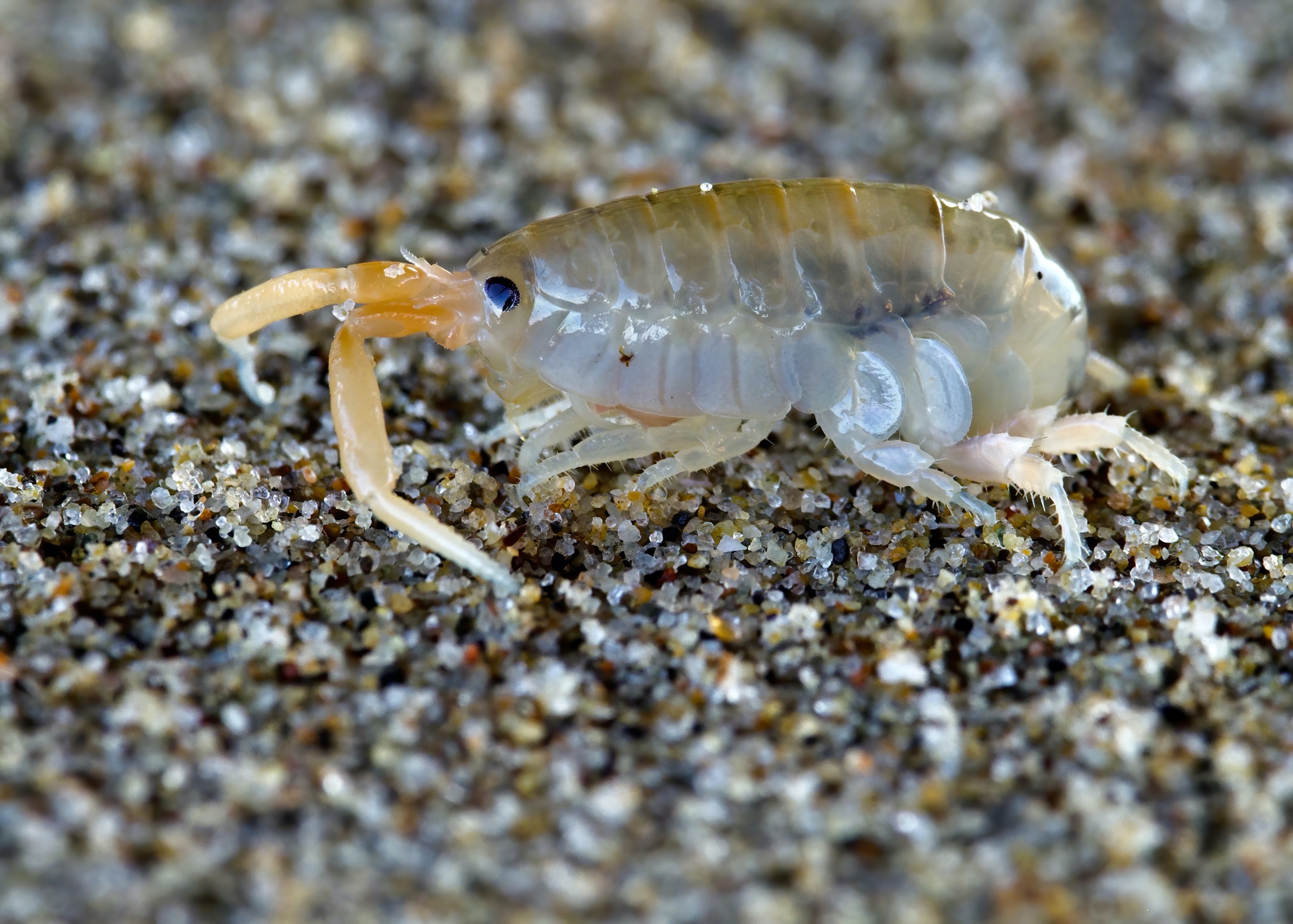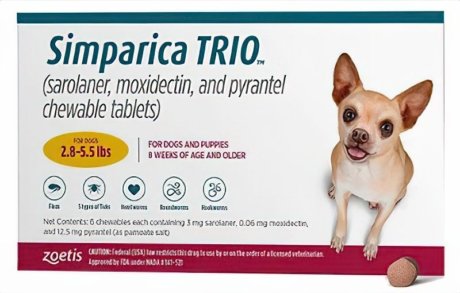Sand Fleas | Bite, Treatment, Size, Sand Fleas On Dogs?
Sand fleas, commonly referred to as beach fleas, are little insects that may be quite uncomfortable for people. They are a kind of crustacean that inhabits sandy regions close to beaches and other bodies of water; they are not fleas. Despite their tiny size, their bites may be highly painful and, if left untreated, can result in illnesses.
We’ll explain what sand fleas are, where they reside, how they impact people, and most importantly, how to get rid of them in this post. We’ll discuss several organic and synthetic treatments for sand flea infestations, as well as recommendations for avoiding further breakouts.
What are Sand Fleas?
Sand fleas are not actually fleas, but rather a type of crustacean that belongs to the order Amphipoda. They are small, typically measuring around 1/8 inch in length, and have a hard exoskeleton that protects them from predators and the harsh environment of the beach.
The mole crab (Emerita talpoida) and common sand flea (Orchestia agilis) are two examples of the many kinds of sand fleas. There are little variations among them despite the fact that they are all identical in look and temperament.
Regular fleas, an insect species that feeds on the blood of animals, are sometimes mistaken for sand fleas. Also, on the other hand, don’t feed on blood; instead, they consume organic material found in the sand, such as algae and plankton.
Sand Fleas Size
Sand flea, also known as beach hoppers, sand crabs, or mole crabs, are small crustaceans that are found along the coasts of oceans and seas worldwide. The size of sand fleas can vary depending on the species, but on average, they range from 1/4 inch to 1 inch in length. Despite their name, sand flea are not actually fleas, and they do not bite humans or animals like traditional fleas do.
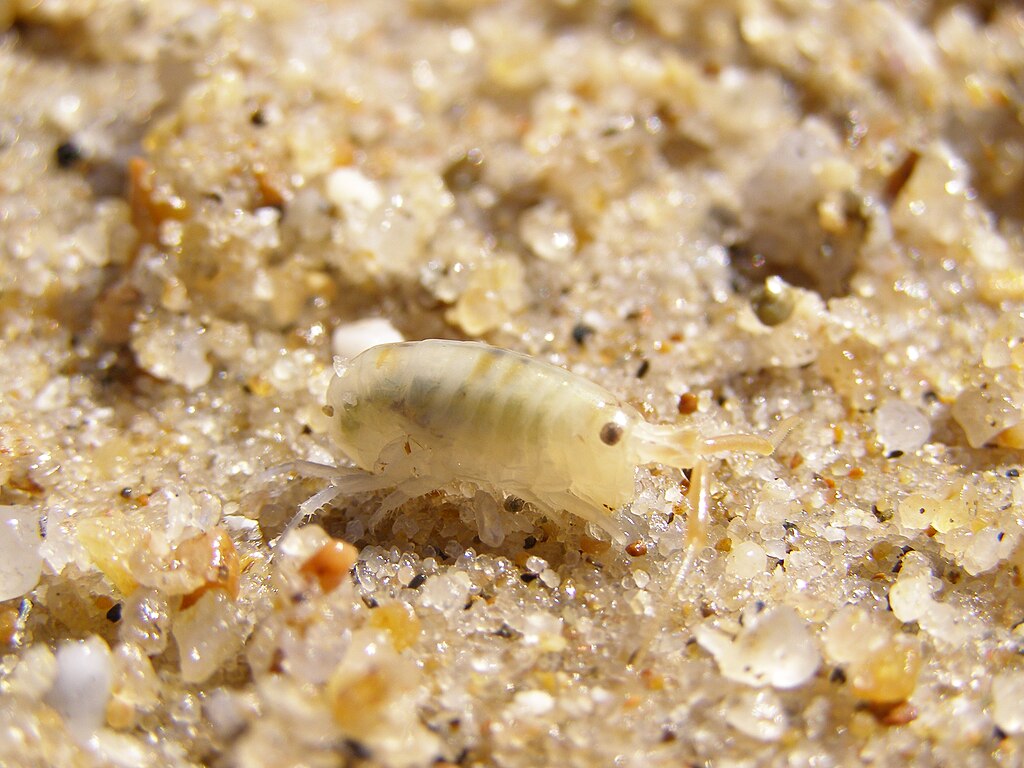
Sand Fleas On Dogs
On dogs that frequent the beach, sand fleas are also common. Dogs may become itchy, scratchy, and uncomfortable from these small crustaceans. Dogs may not be at great risk from sand-fleas as far as health is concerned, but if they are not treated, they can lead to infections and skin irritations. Following a trip to the beach, it’s important to watch your dog’s behaviour and, if necessary, get veterinary care.
Are Sand Fleas Dangerous
Although most species of sand-fleas are harmless to humans, some can carry toxins or parasites that could be harmful if consumed. Prior to consumption, it is essential to accurately identify the species of sand fleas and thoroughly cook them to eliminate any potential health risks. In addition, handling sand-fleas should be done carefully since they can lead to skin illnesses and rashes if they come into touch with the skin.
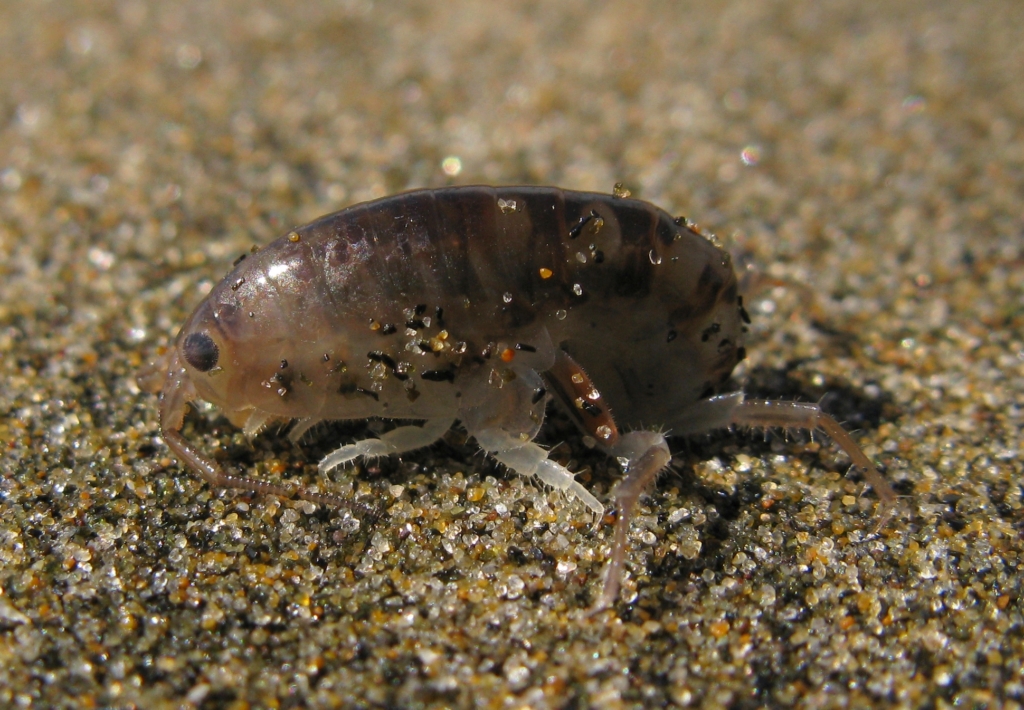
Sand Fleas Parris Island
Parris Island, located in South Carolina, is a famous vacation resort noted for its magnificent beaches. Sand fleas are widespread on Parris Island’s beaches and can be a nuisance to tourists. To avoid being bitten by sand flea, it is important to wear protective clothes and use insect repellent when visiting the beach. Furthermore, it is critical to properly dispose of any trash or debris on the beach to avoid attracting sand flea and other pests.
Sand Flea Bites
Sand flea bites can be a common nuisance for beachgoers and can cause itching, redness, and discomfort. These tiny crustaceans typically bite exposed skin, such as ankles and feet, and can leave behind small, red bumps. While sand flea bites may not be harmful to most people, they can cause severe allergic reactions in some individuals.
Sand Flea Bites On Humans
Sand flea bites on humans are typically harmless, but they can cause skin irritation and discomfort. Symptoms of sand flea bites can include itching, redness, and swelling around the affected area. In rare cases, sand flea bites can cause an allergic reaction, which may require medical attention.

Sand Flea Bites Treatment
Treatment for sand flea bites typically involves cleaning the affected area with soap and water and applying a cold compress to reduce swelling and itching. Over-the-counter antihistamines and topical creams can also help to relieve symptoms. If you experience a severe allergic reaction to a sand flea bite, seek medical attention immediately.
How Long Do Sand Flea Bites Last
The duration of sand flea bites can vary depending on the individual’s sensitivity and the severity of the bite. In most cases, sand flea bites will resolve on their own within a few days to a week. However, if the bites are severe or become infected, they may take longer to heal.
Allergic Reaction To Sand Flea Bites
Individuals may have an allergic reaction to sand flea bites in rare situations, resulting in symptoms such as hives, trouble breathing, and swelling of the face, lips, or tongue. Anaphylaxis is a severe allergic response that need prompt medical intervention. Seek medical attention right away if you suspect you are having an allergic reaction to a sand flea bite.
Where Do Sand Fleas Live?
Sand fleas are commonly found along beaches and other bodies of water in sandy environments. They prefer warm, humid surroundings and are most active during the summer months when the weather is hot and humid.
Sand-fleas flourish on the sand, which is one of the reasons they are so common in these areas. They’ve adapted to their tough surroundings by burying themselves in the sand during the day to avoid the heat and emerging at night to feed.

Sand-fleas can be found in sandy locations other than beaches, such as sand dunes, tidal pools, and marshes.
How Do Sand Fleas Affect Humans?
Sand flea bites may be extremely painful and cause significant discomfort in people. While they are not dangerous, if not treated properly, they can cause infections.
Itching and swelling around the bite site are the most frequent symptoms of a sand flea bite. Blisters may also form in some circumstances. While itching and swelling are unpleasant, it is critical to avoid scratching the bite site, as this can cause further irritation and infection.
Sand flea bites may lead to more significant health problems, such as anaphylaxis or cellulitis. Anaphylaxis is a severe allergic reaction that causes airway swelling, difficulty breathing, and a fast pulse. Cellulitis is a bacterial illness that occurs when the skin surrounding the bite site becomes contaminated.
Can You Eat Sand Fleas
If you like exploring the great outdoors, you may have come across sand flea at some time. These little crustaceans are commonly found in coastal locations and might be a favourite feast for some species of fish. But can people eat sand fleas?
Yes, humans can eat sand fleas. In fact, they are considered a delicacy in various areas of the world, notably in Latin American and Asian countries. Sand-fleas can be deep-fried or cooked.
It is important to remember, however, that not all sand fleas are edible. Some sand flea species may contain toxins or parasites that are harmful to humans. It is important to correctly identify the kind of sand flea you intend to consume and make sure it is safe for food.
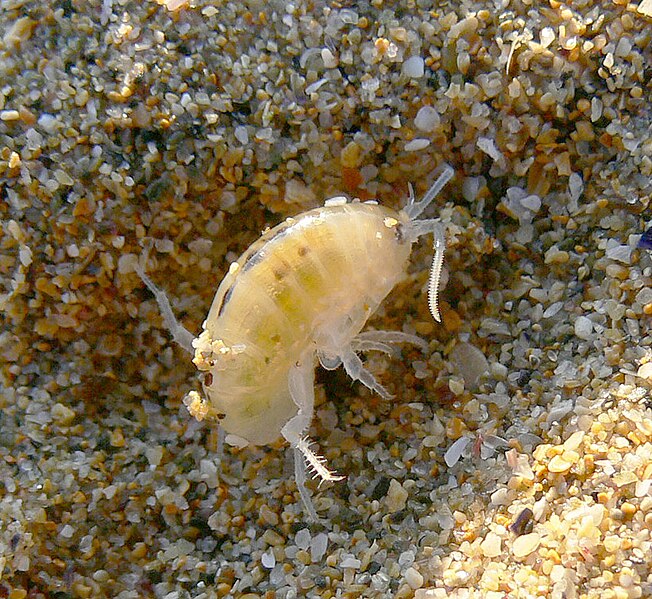
Furthermore, it is always best to thoroughly cook sand fleas before eating them. This will aid in the elimination of any risky bacteria or parasites that may be present.
Are Sand Fleas Edible
If you’ve ever been to the beach, you’ve probably seen small insects called sand fleas running across the sand. Some people wonder if sand-fleas are edible, despite their unpleasant appearance.
Yes, sand fleas are edible and are regarded as a delicacy in some parts of the world. They are a common food source for both people and animals in many coastal areas. Sand flea can be prepared in a variety of ways, including boiling, frying, and even eating raw.
However, it is important to beware when consuming sand-fleas because not all species are safe to eat. Toxins or parasites carried by some sand fleas may be dangerous to humans. It is important to carefully identify the kind of sand flea you intend to consume and make sure it is safe for food.
Furthermore, it is advised to thoroughly cook sand-fleas before eating them. This aids in the elimination of any potentially harmful germs or parasites.
How to Get Rid of Sand Fleas
If you have a sand flea infestation, there are several steps you can take to control the problem. The following are some natural and chemical solutions for controlling sand fleas:
1. Natural remedies:
There are various natural methods for controlling sand flea infestations. Diatomaceous earth, a powder formed from the fossilised remnants of marine animals, is one of the most effective. Diatomaceous earth works by dehydrating and killing sand fleas when sprinkled about the affected region.
Other natural remedies for sand flea control include the use of essential oils, such as tea tree oil, lavender oil, or peppermint oil, which are natural insecticides that repel sand flea. To control sand-fleas, combine a few drops of essential oil with water and spray it on the affected region.
2. Chemical treatments:
If natural solutions do not work, chemical treatments might be used to reduce sand flea infestations. Permethrin, a synthetic pesticide intended to eliminate sand fleas, is one of the most widely used chemical treatments. Permethrin is available as a spray and can be used to control sand fleas contaminated areas.
When using chemical treatments, it essential to follow the instructions on the label and to wear protective clothing and gloves to avoid skin contact with the chemicals.
3. Physical removal:
Another effective way to control sand fleas is to physically remove them from the infested area. You can use a rake or a broom to sweep the sand and remove the sand-fleas. You can also use a vacuum cleaner to suck up the sand-fleas.
4. Preventative measures:
The best way to control sand fleas is to prevent them from infesting your home or yard in the first place. The following are some preventative measures you can take:
- Keep your yard and home clean and free of debris.
- Remove any standing water from your yard.
- Keep your pets clean and free of fleas.
- Use a sand flea repellent spray when you go to the beach.
Conclusion:
Sand fleas are microscopic, yet they may cause significant pain in humans. They are not hazardous, but their bites may be quite painful and can cause to illnesses if not properly treated.
If you have a sand flea infestation, you may control it using a variety of natural and chemical remedies. You can also take precautions to avoid further infestations.
Frequently Asked Question:
What are sand fleas?
Sand fleas, also known as beach fleas, are small crustaceans that live in sandy beaches and can cause painful bites to humans.
How do you treat sand flea bites?
To treat sand flea bites, clean the affected area with soap and water, apply an antiseptic cream or ointment, and take an over-the-counter pain reliever. If the bite becomes infected, seek medical attention.
What do sand flea bites look like?
Sand flea bites typically appear as small, red bumps on the skin that can be itchy and painful. In severe cases, the bites can lead to swelling and blistering.
How do you prevent sand flea bites?
To prevent sand flea bites, wear protective clothing, use insect repellent, and avoid sitting or lying directly on the sand. You can also apply a sand flea repellent spray before going to the beach.
Can sand fleas live in your home?
Sand flea usually live in sandy beaches and do not infest homes. However, they can sometimes be brought into homes on pets or clothing.
What are natural remedies for controlling sand fleas?
Natural remedies for controlling sand fleas include using essential oils, such as tea tree oil or lavender oil, and physically removing the sand-fleas from the infested area.
What are chemical treatments for controlling sand fleas?
Chemical treatments for controlling sand fleas include using synthetic insecticides, such as permethrin, that are designed to kill sand-fleas.
Are sand fleas dangerous?
Sand fleas are not considered dangerous, but their bites can be painful and can lead to infections if not treated properly.
Can sand fleas transmit diseases?
Sand fleas are not known to transmit diseases to humans.
Do sand fleas only bite humans?
Sand fleas can bite both humans and animals, such as dogs and cats.
What is the life cycle of sand fleas?
Sand-fleas have a short life cycle, typically lasting only a few weeks. They lay their eggs in the sand, which hatch into larvae and then develop into adults.
Where are sand fleas most commonly found?
Sand fleas are most commonly found in warm, sandy beaches, especially those near the ocean.
How can you tell if you have a sand flea infestation?
Signs of a sand flea infestation may include the presence of small, red bumps on the skin, as well as the presence of sand fleas in the infested area.
Can you get rid of sand fleas permanently?
Because sand-fleas are naturally present on sandy beaches, getting rid of them permanently can be difficult. However, you can reduce the likelihood of infestations by taking preventative measures such as using insect repellent and keeping your yard clean.
Recommended:
Red Heeler Dog | Price, Breed Profile, Monthly Cost, Care Tips
Brussels Griffon Dog | Price, Breed Profile, Size, weight, Appearance
Images Credit:

























